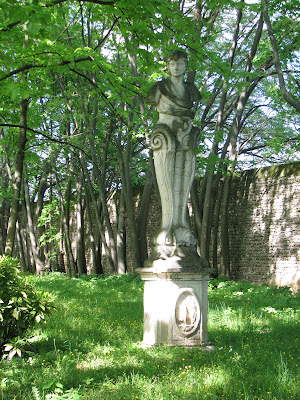Villa Manin, while not as well-kept as the Villa Pisani, is nevertheless as large in scale and impressive in its own right. In the 16th century a local nobleman, Antonio Manin, constructed this large agricultural estate, a working farm as opposed to the pleasure palaces we’ve seen prior. At this time in history, Venice was developing its mainland to offset its loss of dominion of the sea. Antonio’s grandson, while respecting the agricultural heritage, enlarged the estate to a grand scale while also richly decorating the interior. Indeed, it looks more like a palace than a villa. Perhaps that is why it eventually became Napoleon’s headquarters around 1797.
The front of the villa

The “crescent” with the view facing out from the villa

One half of the crescent

As usual, you were not allowed to take pictures of the interior, which is this case was okay. There was only one room decorated with furnishings, again a bedroom of Napoleon. The rest of the villa is given to art displays. The art on display this period was entitled “God and Goods: Spirituality and Mass Confusion,” which sounds like a pretentious argument against religion. However, different artists used all kinds of mediums, photography, painting, sculpture, mobiles, video, all with their own presentations of how art looks at religion from an outside perspective and how that perspective can be personally interpreted. I have to admit, contemporary art is not my thing, but some of these things were interesting. As an art teacher once said, it is the fact that the work makes an impression on you, or makes you think or talk about it, that makes it art. And this exhibit did just that. By the way, the artists were of all nationalities, not just Italian.
The gardens at Villa Manin were more of a park rather than well tended gardens. Acres were enclosed by brick walls, with statues placed here and there.


Paths deviated through trees and vegetation, with benches placed at regular intervals inviting you to sit and enjoy the peacefulness and birdsong. We also observed some fauna – a male pheasant (too slow on the shutter to get the female).

My favorite picture taken today is definitely of this squirrel.


Don’t you love his tufted ears? Like a dark grey version of Tommy Tiptoes. (For Beatrix Potter fans!) Here another one is backlit, so you can see his white chest.

Along the back of the park’s wall, it seemed a bit more “formal” with this arbor and series and elevated “urns”.

Partway along this wall was an opening that still looks out on a large agricultural area of vineyards and orchards

with mountains in the distance.

We entered the villa by a side street and noticed this unique stone wall


complete with letter box.
